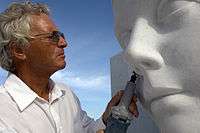Marton Varo
| Marton Varo | |
|---|---|
|
Varo at work on the "Annunciation" at Ave Maria, Florida | |
| Born |
Márton Váró March 15, 1943 Székelyudvarhely, Hungary |
| Occupation | Sculptor |
| Nationality | Hungarian |
| Period | 1961–present |
| Notable works |
"Annunciation" at Ave Maria, Florida "Angels" at Bass Performance Hall, Ft. Worth, Texas |
Márton Váró (born March 15, 1943) is a Hungarian sculptor, recognized for his monumental public art.
Biography
Márton Váró was born in Székelyudvarhely, Hungary (now Odorheiu Secuiesc, Romania) and attended Ion Andreescu Institute of Arts in Cluj, Romania (1960 to 1966), studying sculpture. In 1970, he relocated to Debrecen, Hungary, where he soon completed several sculptures for public places. He was awarded the Munkácsy Prize in 1984.[1]
The recipient of a Fulbright scholarship in 1988, Váró moved to Orange County, California, where he immediately became affiliated with the University of California, Irvine. His initial years in the US were focused on studying the relationship between architecture and sculpture. In 1990, he became the Artist in Residence in the City of Brea, California, for a public art project.[1]
Váró currently lives and works in California, spending summers working in Carrara, Italy, where his marble originates.[1]
Works
Márton Váró primarily uses Carrara marble as the medium for his sculptures; however, he also works with other stones, such as Texas limestone, which was the material of choice for the "Angels" at the Bass Performance Hall in Ft. Worth, Texas. He is noted for his life-size sculptures, which are figurative in nature. His sculptures often depict draped female figures, often emerging from the block of stone from which they are carved. His approach to sculpting is true to classic form, carving directly into the marble or stone, as did the masters like Michelangelo—in fact, Varo's marble comes from the same quarry in Carrara, Italy as did Michelangelo's. The facade of the Ave Maria Oratory church features Váró's 30-foot-tall sculpture of the Annunciation, depicting the Archangel Gabriel greeting the Virgin Mary with the words "Ave Maria" (Hail Mary), with his smaller depiction of Christ the Good Shepherd featured inside. [2] [3] [4]
Awards and scholarships
- 1991 Ladanyi Foundation, New York
- 1989 Fulbright Scholarship, University of California, Irvine
- 1984 Munkacsy Prize
Books
- Watson, Ronald. 1999. "Angels on High: Márton Váró 's Limestone Angels on the Nancy Lee and Perry Bass Performance Hall in Fort Worth, Texas". Texas Christian University Press. ISBN 0-87565-204-2, ISBN 978-0-87565-204-7
References
As of 15 December 2011, this article is derived in whole or in part from martonvaro.com. The copyright holder has licensed the content in a manner that permits reuse under CC BY-SA 3.0 and GFDL. All relevant terms must be followed. The original text was at "Márton Váró".
- 1 2 3 "Biography | Marton Varo | Sculptor In Marble & Stone". Marton Varo. 1943-03-15. Retrieved 2011-12-16.
- ↑ "Ave Maria Oratory Quasi-Parish". Retrieved 19 April 2013.
- ↑ "The Annunciation of Ave Maria by Sculptor Marton Varo". Retrieved 19 April 2013.
- ↑ David Shnaider. "The Ave Maria Herald – Memorial Statue for Alex Klucik Installed in Oratory". Retrieved January 31, 2016.
- Ave Maria Celebrates Unveiling of Annunciation Sculpture
- Unveiling of Annunciation sculpture
- Work on annunciation sculpture resumes at AMU campus
- Work Begins on Annunciation Sculpture for Oratory
- Meet Sculptor Marton Varo
- Bass Performance Hall
- BREA: Civic Center Art Ready to Break Free
